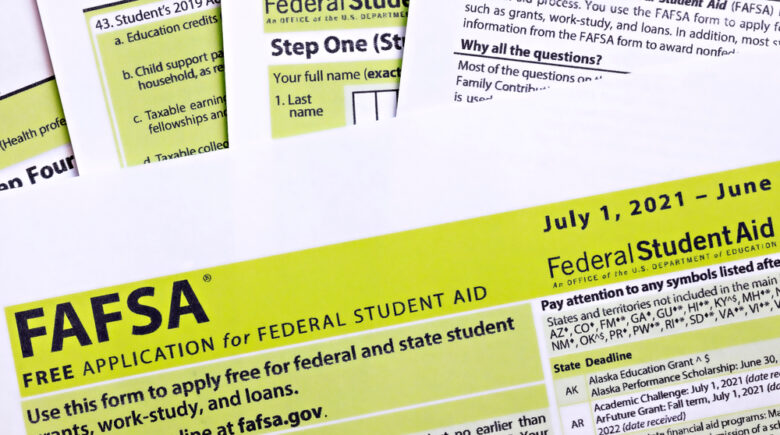Table of Contents
- Understanding the Purpose and Scope of Federal Student Aid
- Key Federal Student Aid Deadlines and Submission Periods
- Required Documentation and Information
- Dependency Status and Its Implications
- Decoding the Student Aid Index (SAI)
- Common Errors and How to Avoid Them
- How FAFSA Data Influences Types of Aid
- Special Circumstances and Appeals
- The Role of FAFSA in Future Years
- Final Thoughts: Maximize Your FAFSA Success
The Free Application for Federal Student Aid (FAFSA) is the gateway to financial support for millions of students pursuing higher education in the United States. Understanding how to accurately complete the FAFSA, when to submit it, and what implications it carries can make a substantial difference in the aid a student receives. This guide offers an in-depth overview of the process, helping students and families navigate each step with clarity and confidence.
Understanding the Purpose and Scope of Federal Student Aid
The FAFSA is an official form managed by the U.S. Department of Education. It determines eligibility for federal student aid programs, including grants, loans, and work-study. Many states and colleges also use FAFSA data to allocate their own financial aid packages.
Aid eligibility hinges primarily on financial need, which is calculated through a formula that considers income, assets, family size, and the number of family members attending college. The FAFSA is not a loan or a scholarship itself—it is a comprehensive application that facilitates access to numerous funding opportunities.
Key Federal Student Aid Deadlines and Submission Periods
Timeliness is critical when it comes to submitting the FAFSA. For the 2025–26 academic year, the form becomes available on October 1, 2024, and the federal deadline is June 30, 2026. However, many states and colleges have earlier deadlines. Submitting the FAFSA as soon as possible after October 1 can maximize aid eligibility, especially for first-come, first-served programs like the Federal Supplemental Educational Opportunity Grant (FSEOG).
In addition to federal deadlines, students should:
- Review their state’s financial aid deadline via the FAFSA website
- Consult individual college financial aid office timelines
- Aim to submit the form within the first few weeks of October
Required Documentation and Information
Preparing accurate documentation in advance is essential to ensure a smooth FAFSA submission. Applicants and their parents (if considered dependents) will need the following:
- Social Security numbers
- Federal income tax returns (typically two years prior)
- W-2 forms and records of untaxed income
- Bank statements and records of investments
- FSA ID for digital signature and application access
For the 2025–26 FAFSA, families will use 2023 tax information. Applicants can streamline this process by utilizing the IRS Direct Data Exchange (DDX), which securely transfers tax data directly into the FAFSA.
Dependency Status and Its Implications
One of the most significant aspects of the FAFSA is determining whether a student is dependent or independent. Dependent students must report parental income and assets, while independent students report only their own (and a spouse’s, if applicable). The FAFSA asks a series of questions to establish dependency, including age, marital status, military service, and graduate-level enrollment.
Dependency affects both the Expected Family Contribution (EFC) and the overall aid eligibility. Independent students often qualify for more aid due to lower total household income and fewer required disclosures.
Decoding the Student Aid Index (SAI)
Beginning with the 2024–25 FAFSA, the term “Expected Family Contribution (EFC)” has been replaced with the Student Aid Index (SAI). The SAI is a numerical measure of a student’s financial need used by colleges to determine aid packages. Unlike the EFC, the SAI can be negative, indicating a greater need for assistance.
Colleges subtract the SAI from their total cost of attendance (COA) to calculate financial need. A lower SAI increases the likelihood of receiving need-based aid such as the Pell Grant, subsidized federal loans, and institutional support.
Common Errors and How to Avoid Them
Mistakes on the FAFSA can delay processing or reduce aid eligibility. Among the most frequent errors:
- Incorrect Social Security numbers or names that do not match federal records
- Omitting required income data or failing to use the IRS DDX
- Listing the wrong school codes or failing to include all potential colleges
- Misreporting asset values or confusing student versus parent income
To mitigate these risks, applicants should double-check all fields, save progress frequently, and avoid submitting the form during high-traffic periods, which can lead to technical delays.
How FAFSA Data Influences Types of Aid
The FAFSA is not limited to federal aid—it plays a role in determining eligibility for:
- Federal Pell Grants – need-based grants for low-income undergraduate students
- Federal Work-Study – part-time employment through school to earn aid
- Federal Direct Loans – both subsidized (need-based) and unsubsidized
- State grants and scholarships – eligibility often requires a FAFSA on file
- Institutional aid – many colleges use FAFSA data to allocate merit and need-based awards
Understanding this interplay ensures that students do not miss out on critical funding sources due to incomplete or late applications.
Special Circumstances and Appeals
Life circumstances can change significantly after a FAFSA is filed. Job loss, illness, or other financial disruptions may render the submitted information outdated. In such cases, students can request a professional judgment review from their college’s financial aid office.
This appeal allows institutions to adjust aid offers based on new documentation and an explanation of the changed circumstances. While there is no guarantee of increased aid, providing thorough and timely information enhances the likelihood of a favorable review.
The Role of FAFSA in Future Years
Completing the FAFSA is not a one-time task. Students must reapply every year they seek aid. Because income and other factors may change annually, so too can aid eligibility. Returning students should use the FAFSA Renewal feature, which pre-fills prior year information to expedite the process.
Staying current with federal updates—such as the 2024 FAFSA simplification overhaul—is also vital, as changes can impact eligibility formulas, required data, and available aid types.
Final Thoughts: Maximize Your FAFSA Success
Navigating the FAFSA requires attention to detail, accurate record-keeping, and early preparation. By understanding deadlines, submitting complete information, and proactively addressing special circumstances, students can significantly increase their chances of securing the financial aid needed to access higher education.
For those seeking further assistance, the Federal Student Aid Information Center (FSAIC), high school guidance counselors, and college financial aid offices offer valuable support.
References:
- U.S. Department of Education. “FAFSA® Application | Federal Student Aid.” https://studentaid.gov/h/apply-for-aid/fafsa
- National College Attainment Network. “FAFSA Simplification: Key Changes.” https://www.ncan.org/page/fafsa-simplification
- Federal Student Aid. “FAFSA Deadlines.” https://studentaid.gov/apply-for-aid/fafsa/fafsa-deadlines
Table of Contents
- Understanding the Purpose and Scope of Federal Student Aid
- Key Federal Student Aid Deadlines and Submission Periods
- Required Documentation and Information
- Dependency Status and Its Implications
- Decoding the Student Aid Index (SAI)
- Common Errors and How to Avoid Them
- How FAFSA Data Influences Types of Aid
- Special Circumstances and Appeals
- The Role of FAFSA in Future Years
- Final Thoughts: Maximize Your FAFSA Success
The Free Application for Federal Student Aid (FAFSA) is the gateway to financial support for millions of students pursuing higher education in the United States. Understanding how to accurately complete the FAFSA, when to submit it, and what implications it carries can make a substantial difference in the aid a student receives. This guide offers an in-depth overview of the process, helping students and families navigate each step with clarity and confidence.
Understanding the Purpose and Scope of Federal Student Aid
The FAFSA is an official form managed by the U.S. Department of Education. It determines eligibility for federal student aid programs, including grants, loans, and work-study. Many states and colleges also use FAFSA data to allocate their own financial aid packages.
Aid eligibility hinges primarily on financial need, which is calculated through a formula that considers income, assets, family size, and the number of family members attending college. The FAFSA is not a loan or a scholarship itself—it is a comprehensive application that facilitates access to numerous funding opportunities.
Key Federal Student Aid Deadlines and Submission Periods
Timeliness is critical when it comes to submitting the FAFSA. For the 2025–26 academic year, the form becomes available on October 1, 2024, and the federal deadline is June 30, 2026. However, many states and colleges have earlier deadlines. Submitting the FAFSA as soon as possible after October 1 can maximize aid eligibility, especially for first-come, first-served programs like the Federal Supplemental Educational Opportunity Grant (FSEOG).
In addition to federal deadlines, students should:
- Review their state’s financial aid deadline via the FAFSA website
- Consult individual college financial aid office timelines
- Aim to submit the form within the first few weeks of October
Required Documentation and Information
Preparing accurate documentation in advance is essential to ensure a smooth FAFSA submission. Applicants and their parents (if considered dependents) will need the following:
- Social Security numbers
- Federal income tax returns (typically two years prior)
- W-2 forms and records of untaxed income
- Bank statements and records of investments
- FSA ID for digital signature and application access
For the 2025–26 FAFSA, families will use 2023 tax information. Applicants can streamline this process by utilizing the IRS Direct Data Exchange (DDX), which securely transfers tax data directly into the FAFSA.
Dependency Status and Its Implications
One of the most significant aspects of the FAFSA is determining whether a student is dependent or independent. Dependent students must report parental income and assets, while independent students report only their own (and a spouse’s, if applicable). The FAFSA asks a series of questions to establish dependency, including age, marital status, military service, and graduate-level enrollment.
Dependency affects both the Expected Family Contribution (EFC) and the overall aid eligibility. Independent students often qualify for more aid due to lower total household income and fewer required disclosures.
Decoding the Student Aid Index (SAI)
Beginning with the 2024–25 FAFSA, the term “Expected Family Contribution (EFC)” has been replaced with the Student Aid Index (SAI). The SAI is a numerical measure of a student’s financial need used by colleges to determine aid packages. Unlike the EFC, the SAI can be negative, indicating a greater need for assistance.
Colleges subtract the SAI from their total cost of attendance (COA) to calculate financial need. A lower SAI increases the likelihood of receiving need-based aid such as the Pell Grant, subsidized federal loans, and institutional support.
Common Errors and How to Avoid Them
Mistakes on the FAFSA can delay processing or reduce aid eligibility. Among the most frequent errors:
- Incorrect Social Security numbers or names that do not match federal records
- Omitting required income data or failing to use the IRS DDX
- Listing the wrong school codes or failing to include all potential colleges
- Misreporting asset values or confusing student versus parent income
To mitigate these risks, applicants should double-check all fields, save progress frequently, and avoid submitting the form during high-traffic periods, which can lead to technical delays.
How FAFSA Data Influences Types of Aid
The FAFSA is not limited to federal aid—it plays a role in determining eligibility for:
- Federal Pell Grants – need-based grants for low-income undergraduate students
- Federal Work-Study – part-time employment through school to earn aid
- Federal Direct Loans – both subsidized (need-based) and unsubsidized
- State grants and scholarships – eligibility often requires a FAFSA on file
- Institutional aid – many colleges use FAFSA data to allocate merit and need-based awards
Understanding this interplay ensures that students do not miss out on critical funding sources due to incomplete or late applications.
Special Circumstances and Appeals
Life circumstances can change significantly after a FAFSA is filed. Job loss, illness, or other financial disruptions may render the submitted information outdated. In such cases, students can request a professional judgment review from their college’s financial aid office.
This appeal allows institutions to adjust aid offers based on new documentation and an explanation of the changed circumstances. While there is no guarantee of increased aid, providing thorough and timely information enhances the likelihood of a favorable review.
The Role of FAFSA in Future Years
Completing the FAFSA is not a one-time task. Students must reapply every year they seek aid. Because income and other factors may change annually, so too can aid eligibility. Returning students should use the FAFSA Renewal feature, which pre-fills prior year information to expedite the process.
Staying current with federal updates—such as the 2024 FAFSA simplification overhaul—is also vital, as changes can impact eligibility formulas, required data, and available aid types.
Final Thoughts: Maximize Your FAFSA Success
Navigating the FAFSA requires attention to detail, accurate record-keeping, and early preparation. By understanding deadlines, submitting complete information, and proactively addressing special circumstances, students can significantly increase their chances of securing the financial aid needed to access higher education.
For those seeking further assistance, the Federal Student Aid Information Center (FSAIC), high school guidance counselors, and college financial aid offices offer valuable support.
References:
- U.S. Department of Education. “FAFSA® Application | Federal Student Aid.” https://studentaid.gov/h/apply-for-aid/fafsa
- National College Attainment Network. “FAFSA Simplification: Key Changes.” https://www.ncan.org/page/fafsa-simplification
- Federal Student Aid. “FAFSA Deadlines.” https://studentaid.gov/apply-for-aid/fafsa/fafsa-deadlines







